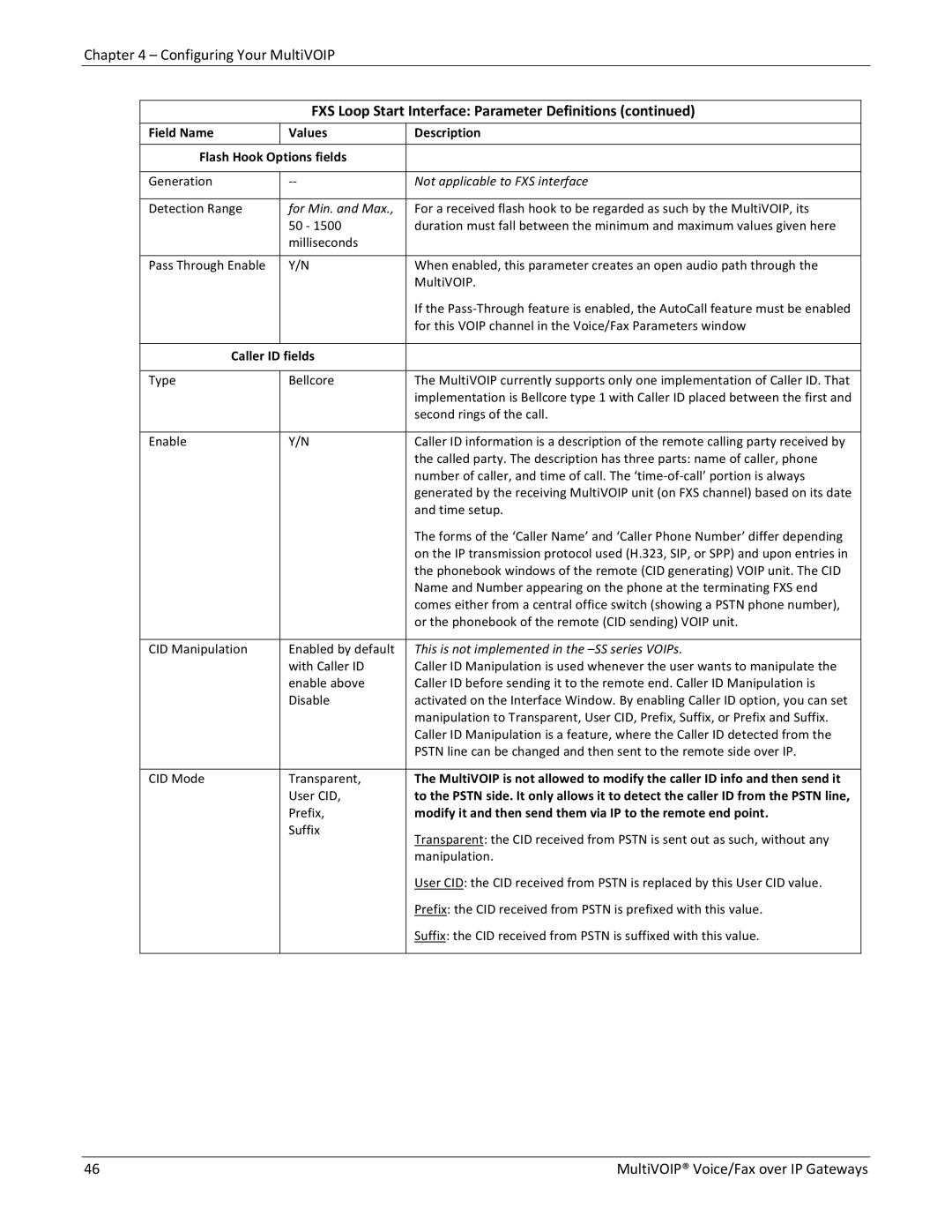
Chapter 4 – Configuring Your MultiVOIP
FXS Loop Start Interface: Parameter Definitions (continued)
Field Name | Values | Description |
|
|
|
Flash Hook Options fields |
| |
|
|
|
Generation | ‐‐ | Not applicable to FXS interface |
|
|
|
Detection Range | for Min. and Max., | For a received flash hook to be regarded as such by the MultiVOIP, its |
| 50 ‐ 1500 | duration must fall between the minimum and maximum values given here |
| milliseconds |
|
|
|
|
Pass Through Enable | Y/N | When enabled, this parameter creates an open audio path through the |
|
| MultiVOIP. |
|
| If the Pass‐Through feature is enabled, the AutoCall feature must be enabled |
|
| for this VOIP channel in the Voice/Fax Parameters window |
|
|
|
Caller ID fields |
| |
|
|
|
Type | Bellcore | The MultiVOIP currently supports only one implementation of Caller ID. That |
|
| implementation is Bellcore type 1 with Caller ID placed between the first and |
|
| second rings of the call. |
|
|
|
Enable | Y/N | Caller ID information is a description of the remote calling party received by |
|
| the called party. The description has three parts: name of caller, phone |
|
| number of caller, and time of call. The ‘time‐of‐call’ portion is always |
|
| generated by the receiving MultiVOIP unit (on FXS channel) based on its date |
|
| and time setup. |
|
| The forms of the ‘Caller Name’ and ‘Caller Phone Number’ differ depending |
|
| on the IP transmission protocol used (H.323, SIP, or SPP) and upon entries in |
|
| the phonebook windows of the remote (CID generating) VOIP unit. The CID |
|
| Name and Number appearing on the phone at the terminating FXS end |
|
| comes either from a central office switch (showing a PSTN phone number), |
|
| or the phonebook of the remote (CID sending) VOIP unit. |
|
|
|
CID Manipulation | Enabled by default | This is not implemented in the |
| with Caller ID | Caller ID Manipulation is used whenever the user wants to manipulate the |
| enable above | Caller ID before sending it to the remote end. Caller ID Manipulation is |
| Disable | activated on the Interface Window. By enabling Caller ID option, you can set |
|
| manipulation to Transparent, User CID, Prefix, Suffix, or Prefix and Suffix. |
|
| Caller ID Manipulation is a feature, where the Caller ID detected from the |
|
| PSTN line can be changed and then sent to the remote side over IP. |
|
|
|
CID Mode | Transparent, | The MultiVOIP is not allowed to modify the caller ID info and then send it |
| User CID, | to the PSTN side. It only allows it to detect the caller ID from the PSTN line, |
| Prefix, | modify it and then send them via IP to the remote end point. |
| Suffix | Transparent: the CID received from PSTN is sent out as such, without any |
|
| |
|
| manipulation. |
|
| User CID: the CID received from PSTN is replaced by this User CID value. |
|
| Prefix: the CID received from PSTN is prefixed with this value. |
|
| Suffix: the CID received from PSTN is suffixed with this value. |
|
|
|
46 | MultiVOIP® Voice/Fax over IP Gateways |
